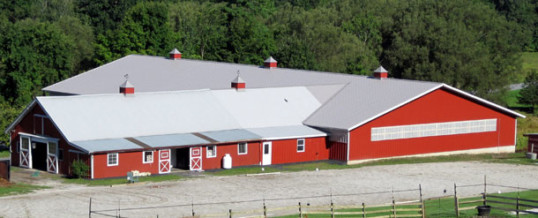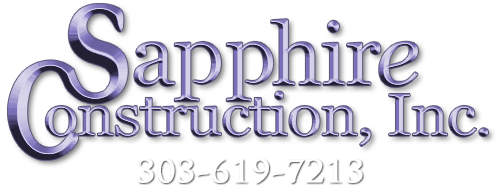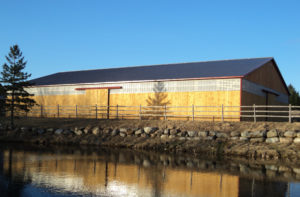
How to Build Indoor Riding Arenas in Colorado
In Colorado equestrians like to have both indoor and outdoor arenas, also called schools. Although, they come with greater expenses–increased property taxes, and electrical and lighting expenses, covered equestrian arenas provide the best protection from the weather. Well-designed, indoor arenas can up the game in any equestrian discipline. The design for riding arenas must emphasize safety–for horses, riders, and spectators.
If you’d like to build an arena in Colorado, you’ll need to study several aspects. We’ll go over a handful here including size, design, location, layout, and surfaces. Naturally, each owner comes to us with his/her own ideas, dreams, these factors vary for each owner.
Each of you will be making choices with your budget in mind. Our partner architects and engineers and contractors have built hundreds of distinctive arenas over 75 years. And so, we find lots of variation between the horse arenas already in existence. This is s short primer on how you’ll need to start thinking about building your unique indoor equestrian arena here in Colorado.
Size of Riding Arena
Exact dimensions for a riding arena may depend upon the purpose. An adequate indoor arena for one horse would not be big enough for multiple simultaneous activities. The clear span of a common pole building tops out at about 90 feet wide. However, there’s not a restriction on the length, unless they come from local regulations or costs.
Regulated activities, such as Olympic dressage and venting, demand specific measurements (120’ x 200’). Home practice arenas can make do with smaller spaces like 80’ x 150’. While 60′ x 100′ may feel small, it could work in a Douglas County subdivision.
The ceiling shape and height makes a big difference, especially for jumping. You’ll need 18 feet to practice jumping. The smaller arenas may have shorter roof height at the eaves, let’s say 12 or 14 feet, but could be more useful with 16 to 18 feet at the height. Likewise, openings, doorways, need to be wide enough to accommodate equipment.
Designs for Equestrian Arenas
As mentioned, safety comes before the aesthetics of a riding arena. The best advice is to choose materials wisely because cheap and inferior surfaces will not last around the intense activities. In fact, you’ll want a reputable construction company with arena experience to tackle the project. These builders know the value of safety.
Seemingly little things need an expert eye. The builder will know you want smooth surfaces, sufficient fencing, and the best flooring. In addition, you’ll want your horse riding arena to withstand the Colorado weather. Find a company with the equipment and experience to engineer huge pole buildings.
Location – Regulations, Setting, Direction
Experienced Colorado builders can help you sort out the building permits and subdivision regulations. If you plan to have an open air facility, codes and regulations effect your lighting plans. The building site will need to be flat and able to drain rainwater and snowmelt. Another consideration will be placement in relation to the sunrise and sunset, prevailing winds, and other natural aspects.
Areas of Activity
As you determine the design of your arena, think about the spaces needed. For example, you will need a way to store your equipment. Think about specialty racks, machinery storage, or adding stables. If this is an indoor riding arena for an organization or an equestrian subdivision, will you need a viewing gallery or a judges’ box?
In addition, back at home you want your arena close to your stable, tack room, and wash bays. There are plenty of spaces in Elbert County where an arena could be in view of the home.
Surfaces used for Horse Arenas
Here comes an especially important design element: the surface or flooring. In all cases you will need a correct base under the top surface layer. In preparing the ground, the builder will examine drainage issues and install membranes. You’ll need to remove rocks and stumps to create a homogeneous surface throughout the arena.
Then comes the material you choose to put over the base. Your surface choices will depend upon your budget and your needs. Here’s a list of surfaces to investigate:
Sand
Waxed coded surfaces
Synthetic surfaces
Wood chips
Rubber surfaces
Cushion surfaces
Carpet fiber
Call Sapphire Construction, Inc.
We’d love to hear about your equine building dreams. Have we convinced you to give us a call at Sapphire Construction, Inc. in Castle Rock? Call at (303) 619-7213.
Our design and construction team offers decades of experience building equestrian arenas. Arenas throughout the USA stand as testament to our fastidiousness. And we offer a lifetime warranty with each custom pole buildings. Find out about our equestrian barns and arenas built with high-quality, engineer-tested materials from Lester Buildings.
OCT
2022


About the Author:
Allen Randa is a second generation Master Carpenter and Owner of Sapphire Construction Inc. Allen personally manages each project from beginning to end. That includes the first meeting, the estimate, the contract and architectural designs.